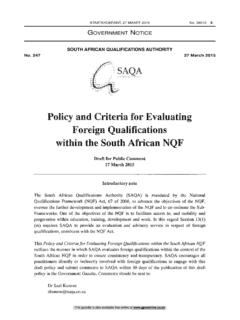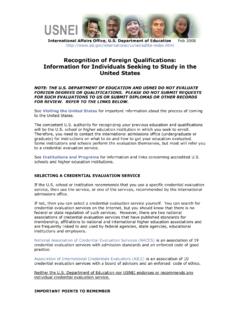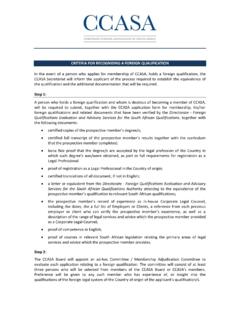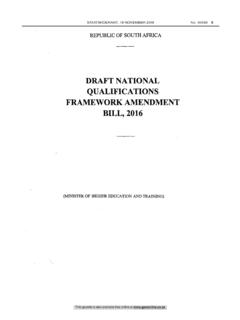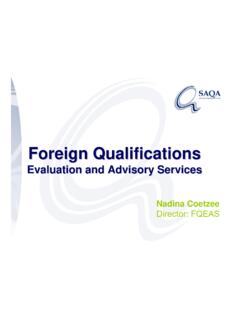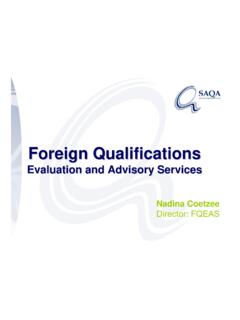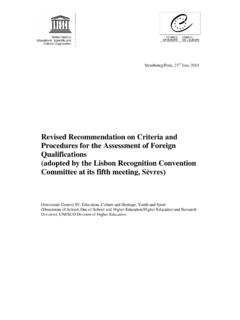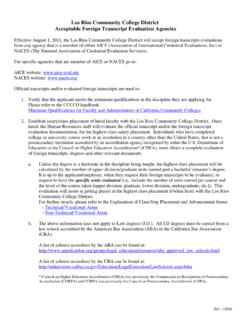Transcription of APPROACHES TO INTERNATIONAL DEGREE RECOGNITION - …
1 DEGREE RECOGNITION : A COMPARATIVE STUDY APPROACHES TO INTERNATIONAL November 2012 INTERNATIONAL Education Research Foundation, Inc. Emily Tse APPROACHES TO INTERNATIONAL DEGREE RECOGNITION : A Comparative Study 2 NOTE: APPROACHES to INTERNATIONAL DEGREE RECOGNITION is copyrighted and may not be reproduced for commercial purposes. No part of this publication can be reproduced or transmitted in any form or by any meanswithout permission in writing from the author. APPROACHES TO INTERNATIONAL DEGREE RECOGNITION : A Comparative Study 3 THE PIONEER FUND This resource was supported in large part by the Pioneer Fund. With the help of donations, this grant was established in 2003 to honor the memories of those individuals who contributed to the field of INTERNATIONAL admissions and credentials evaluation .
2 The funds are used to encourage research as well as professional development in this area. I am very honored and grateful to be a beneficiary and particularly wish to thank the members of the Steering Committee for their guidance and patience. They are Rebecca Dixon, Christine Kerlin and Leo Sweeney. For other publications sponsored by the Pioneer Fund, please see FURTHER ACKNOWLEDGEMENTS I would also like to express my appreciation to INTERNATIONAL Education Research Foundation (IERF) for its support of this research project. In particular, I am grateful to Susan Bedil, the Executive Director, and to the Board. I am also fortunate to have benefitted from the feedback and assistance of Traci Wells and Amy Santiago at IERF.
3 I am also thankful to Kay McIntosh, Patricia Arinto, and Mami Umayahara at the Institute of Education in London for their encouragement and counsel. I also wish to express my thanks to the European Association of INTERNATIONAL Education (EAIE) for allowing me to sit in and observe their workshop on INTERNATIONAL credentials evaluation . I learned a great deal from the trainers, Jessica Stannard of NUFFIC and Erwin Malfroy of the Flemish Ministry of Education. APPROACHES TO INTERNATIONAL DEGREE RECOGNITION : A Comparative Study 4 CONTENTS Background 5 Focus of Study and Data Collection 6 A Review of Related Studies 8 Criteria Used in the evaluation of foreign Educational Credentials 9 The Data 10 Data Analysis: The American Approach 10 Data Analysis: The Australian Approach 11 Data Analysis: The British Approach 14 Data Analysis: The German Approach 15 Data Analysis: The Bologna Process 17 Challenges and Limitations 19 Summary and Concluding Remarks 20 Bibliography 21 Appendices: Introduction 24 Appendix I.
4 Table of Equivalencies for Secondary-Level Credentials 25 Appendix II: Table of Equivalencies for First University Degrees 60 Appendix III: Views on US Qualifications 97 APPROACHES TO INTERNATIONAL DEGREE RECOGNITION : A Comparative Study 5 BACKGROUND Due to advances in technology, the movement of students and professionals globally has become commonplace today. Not only do individuals gain from widening their opportunities across countries in education and in employment, but the receiving countries benefit as well, whether it is economically or in terms of having access to a broader range of candidates and skill sets. Where the marketplace is concerned, one only has to think of industries in the health sciences and information technology, where the best are often recruited internationally and aggressively (Aiken et al 2004 and OECD 2002).
5 Despite the global recession, data also shows that INTERNATIONAL education is on the rise (Redden 2009). In the 2008-09 academic year, a record number of foreign students pursued higher education in the US, contributing $18 billion to the economy (LaFranchi 2009). INTERNATIONAL education is also one of the top industries in Australia, surpassing even beef and wool (Altbach 2003 and Ashwill 2003). As a result, regions like Australia and the UK have marketed heavily, also investing in INTERNATIONAL student services on university campuses and streamlining the student visa process. The Bologna Process is perhaps the best example of collected efforts to participate more actively in the INTERNATIONAL education market.
6 During a meeting in Bologna, Italy in 1999, officials in Europe proposed to harmonize their post-secondary educational systems and to offer programs in English, with the aim of facilitating more interest in their educational programs and the RECOGNITION of their corresponding degrees globally (Teichler 2001 and Teichler 2003). This harmonization has resulted in a common three-cycle educational system for tertiary-level studies: the bachelor s, master s and doctorate degrees. With currently 46 signatory countries, this kind of pan-European movement is unprecedented in the history of education. As INTERNATIONAL mobility has increased within the last several decades, the need for formal credentials evaluation services has also emerged.
7 Credentials evaluators typically provide advisory services with regard to determining the educational equivalency of a foreigner s credentials. In most cases, however, the final decision for admission, employment or professional licensure is left to the institution or organization that is screening the applicant. The credentials evaluation field is a relatively young one and its development varies from region to region. In many countries, there is one centralized office appointed by the ministry or department of education. In Europe, for example, these are frequently known as ENIC-NARIC centers which form a network (European Network of National Information Centres on Academic RECOGNITION and Mobility).
8 On the other hand, there are still countries where a formalized service has not yet been developed, such as in Japan (Assefa and Stannard 2008). APPROACHES TO INTERNATIONAL DEGREE RECOGNITION : A Comparative Study 6 In the United States, there are many agencies which provide credentials evaluations; however, this has not always been the case. In 1919, a foreign Credentials evaluation Service (FCES) was created within the US Office of Education, a branch of the Department of the Interior, to handle requests for assistance in this area. However, by the 1960s, the volume of requests far exceeded the resources of FCES, and the service gradually dissolved (Frey, date unknown).
9 In the meantime, a voluntary collaboration among various organizations resulted in the establishment of the National Council for the evaluation of foreign Educational Credentials in 1956 (Kerlin 2010). Relying on peer review, the Council, as it came to be called, helped develop guidelines and processes that facilitated standards in the evaluation of INTERNATIONAL credentials. The Council further facilitated the refinement of these guidelines in 1996 with the Milwaukee Symposium (Fletcher and Aldrich-Langen 1997). Although the Council dissolved a decade later in 2006, the evaluation methodologies and standards it devised continue to form the backbone of most current APPROACHES to credentials evaluation in the US.
10 The latter part of the twentieth century also saw growth in private evaluation agencies and there are now over a hundred in the field. Many specialize in particular areas and offer evaluations in these areas only, such as for immigration or licensure in a specific profession. Alt hough these agencies are not government-regulated, there is an industry effort to assure standards through the voluntary association of NACES, the National Association of Credential evaluation Services. This association was established in 1987. FOCUS OF STUDY AND DATA COLLECTION This paper examines the approach to credentials evaluation in the following regions: Australia, Germany, the and the According to the statistics available on INTERNATIONAL student mobility, these regions make up four of the top five destination countries (American Council on Education 2009).

